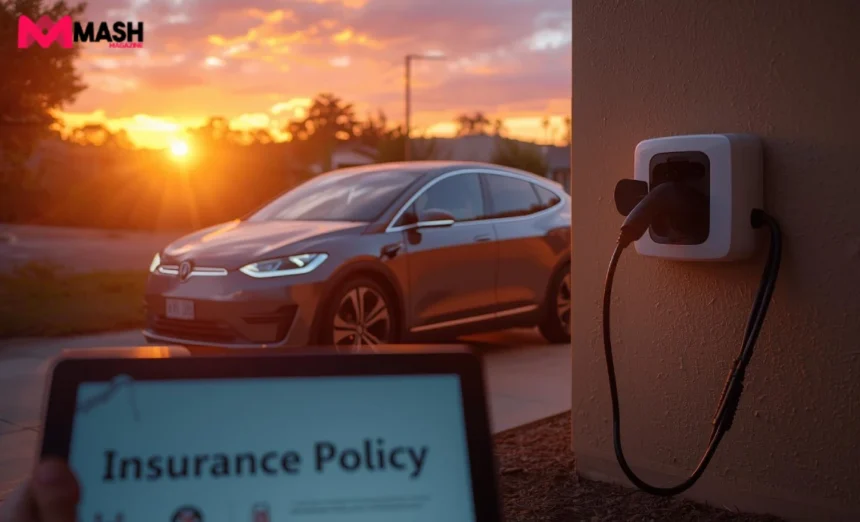You bought an electric vehicle for cleaner driving and lower running costs. But when you looked for insurance, you found a different landscape. Premiums sit higher than expected. Policies include terms you’ve never seen before. Battery cover, charger liability, and specialist repair networks now matter.
- How electric vehicle insurance in Australia differs from standard cover
- What electric vehicle insurance in Australia actually covers
- Why EV repairs cost more than traditional vehicles
- EV insurance premium costs across Australia
- How to choose the right EV insurance policy
- Questions to ask before you buy EV insurance
- Getting the right cover for your electric vehicle
- FAQs
Electric vehicle insurance in Australia works differently from traditional car insurance. The risks are different. The costs are different. The cover you need is different too.
This guide explains how EV insurance works, what it covers, and how to choose the right policy. You’ll learn why insurers treat electric cars differently, what protection you actually need, and how to compare policies without overpaying.
How electric vehicle insurance in Australia differs from standard cover
Electric vehicle insurance in Australia covers the same basics as regular car insurance. Third-party, fire, theft, and collision damage all work the same way. But insurers add specific terms for EV components that don’t exist in petrol cars.
Your policy needs to account for the battery pack, which can cost $15,000 to $30,000 to replace. It needs to cover home charging equipment, which connects to your electrical system. It needs to address repair networks, because not every mechanic can work on high-voltage systems.
Most major insurers now offer EV-specific policies. NRMA, RACV, and Budget Direct all include battery cover in their comprehensive plans. Some add roadside charging assistance. Others cover rental cars while your EV sits in a specialist repair shop.
1. Key differences between EV and petrol car insurance
Battery damage sits at the top of the list. If your battery fails due to an accident, your policy should cover replacement or repair. Manufacturer warranties cover defects, but insurance covers collision and fire damage.
Repair costs run higher because fewer technicians hold EV certification. Parts take longer to arrive. Your car might need towing to a distant repair center instead of a local shop.
Charging equipment adds another layer. Your home wallbox connects to your house’s electrical system. If it causes a fire or electrical fault, you need liability cover. If someone steals your portable charger, you need a contents or vehicle cover to replace it.
2. Why insurers assess EV risk differently
Battery replacement costs drive premium calculations. A minor collision that damages the battery casing can trigger a total write-off. Insurers can’t always repair battery packs. They replace them, which costs more than fixing an engine.
Fire risk matters too. Lithium-ion battery fires burn hotter and longer than petrol fires. They need different suppression methods. Some insurers factor this into their risk models, though actual fire rates in EVs remain low.
Limited repair networks increase claim costs. Your EV might need transport to the nearest certified repairer, which could be 200 kilometers away. Hire car costs add up while you wait weeks for parts from overseas suppliers.

What electric vehicle insurance in Australia actually covers
Comprehensive electric vehicle insurance in Australia covers all standard risks plus EV-specific components. You get collision, theft, fire, and third party damage cover. Then you add battery protection, charging equipment, and specialist repair access.
Most policies include battery cover automatically in comprehensive plans. This protects your battery if an accident damages it. The cover applies whether the damage comes from a collision, vandalism, or fire.
Charging equipment cover varies by insurer. Some policies cover home wallboxes up to $2,000. Others exclude home charging units but cover portable cables. You need to check what your policy includes before you assume anything.
1. Battery cover and how it works with warranties
Your EV manufacturer provides a battery warranty, usually for eight years or 160,000 kilometers. This warranty covers capacity loss and manufacturing defects. It does not cover accident damage, fire, or vandalism.
Insurance covers what warranties don’t. If someone crashes into your parked EV and damages the battery pack, your comprehensive policy pays for replacement. If your battery gradually loses capacity through normal use, your manufacturer’s warranty handles it.
Some insurers require battery health checks before they’ll cover older EVs. If your battery has degraded below 70% capacity, you might face higher premiums or coverage limits. This practice is still developing as more EVs age into the second-hand market.
2. Charger and cable protection under EV policies
Home wallbox chargers cost between $800 and $2,500 installed. If yours gets damaged in a storm, vandalised, or causes an electrical fault, you need specific cover. Some insurers include this in comprehensive EV policies. Others require you to add it through home insurance.
Portable charging cables get stolen more often than you’d expect. They sit in your boot or garage, visible and easy to grab. A replacement Level 2 cable costs $400 to $800. Check whether your policy covers theft from your vehicle or only from your locked garage.
Liability cover matters for charging equipment. If your wallbox malfunctions and damages someone else’s car while they’re using it, you need public liability protection. Most comprehensive policies include this, but confirm it in writing.
Why EV repairs cost more than traditional vehicles
Electric vehicle repairs in Australia cost 20% to 40% more than equivalent petrol car repairs. The parts cost more. The labour costs more. The wait times stretch longer.
You need certified technicians to work on high-voltage systems. Regular mechanics don’t have the training or equipment. This limits your repair options to approved workshops, which often charge premium rates.
Parts availability creates delays. If your EV needs a specific battery module or inverter, it might ship from overseas. You could wait six to twelve weeks for parts that a dealer in Australia doesn’t stock. Your hire car costs add up during this time.
1. Factors that push EV repair costs higher
Specialist training requirements mean fewer workshops can handle EV repairs. Technicians need certification to work safely with high-voltage systems above 60 volts. Your Tesla, BYD, or Hyundai Ioniq runs at 400 to 800 volts.
Diagnostic equipment costs thousands. Workshops need EV-specific scan tools and isolation equipment. Smaller repair shops don’t invest in this gear because they don’t see enough EV work yet. This concentrates repairs at larger approved centers.
Battery diagnostics take time. After an accident, technicians must test every cell in your battery pack to confirm safety. This process can take days. If they find damage, the whole pack often needs replacement because individual module repairs aren’t always possible.
2. Total loss claims and battery fire scenarios
Insurers write off EVs more readily than petrol cars when battery damage occurs. A damaged battery casing might mean total loss, even if the rest of your car looks fine. The replacement cost exceeds the vehicle’s value in many cases.
Battery fires trigger special protocols. Fire services often submerge burned EVs in water tanks for 24 to 48 hours to prevent re-ignition. Your insurer writes off any EV that’s been submerged. Some insurers also write off EVs that were parked near battery fires, even if they weren’t directly burned.
Claim settlements for total loss use agreed value or market value, just like regular cars. But EV market values can drop faster than petrol cars as new models with better range arrive. Check whether your policy offers agreed value or market value before you buy.
EV insurance premium costs across Australia
Electric vehicle insurance premiums in Australia run 15% to 30% higher than premiums for equivalent petrol cars. The gap varies by model, location, and insurer. A Tesla Model 3 costs more to insure than a Toyota Camry, even when both cars cost the same to buy.
Your premium reflects repair costs, parts availability, and claim history for your specific model. Popular EVs with good repair networks cost less to insure. Rare imported models with limited parts support cost more.
Location matters too. If you live in Sydney or Melbourne, you’ll find more EV repair options nearby. Regional drivers face higher premiums because their cars need transport to capital cities for specialist work.
1. What determines your EV insurance premium
Vehicle value sits at the top. More expensive EVs cost more to insure because replacement costs run higher. A $65,000 Tesla Model Y costs more to insure than a $45,000 BYD Atto 3.
Your driving history affects premiums just like any other car insurance. Claims history, license type, and years of driving experience all factor in. Young drivers pay more. Drivers with recent claims pay more.
Battery age and condition matter for older EVs. Some insurers check battery health before quoting. If your battery has degraded significantly, you might face higher premiums or coverage limits. This affects second-hand EV buyers more than new car buyers.
2. Premium examples from Australian insurers
A Tesla Model 3 Standard Range Plus costs around $1,200 to $1,800 per year for comprehensive cover in Sydney. That’s for a driver aged 35 to 50 with a clean record. The same driver might pay $900 to $1,300 for a Toyota Camry worth a similar amount.
A Hyundai Kona Electric runs about $1,000 to $1,500 annually for the same coverage. The lower price reflects cheaper parts and wider repair network access. Budget Direct and RACV both quote competitive rates for this model.
A BYD Atto 3 costs $950 to $1,400 for comprehensive cover. The growing popularity of BYD in Australia has pushed premiums down as more repairers gain certification. Two years ago, BYD quotes ran 20% higher due to limited repair options.
How to choose the right EV insurance policy
Start by comparing at least three insurers who specifically mention EV cover in their policies. Don’t assume regular comprehensive insurance covers everything your EV needs. Ask direct questions about battery cover, charger protection, and repair network access.
Check the excess amounts carefully. Standard excesses might sit at $600 to $800. But some insurers add a separate battery excess of $1,000 to $2,000. This means you pay more if your claim involves battery damage.
Look for agreed value policies if your EV is new or recently purchased. Market value policies can undervalue EVs because the market changes fast. An agreed value locks in your payout amount for the policy period.
Compare cover levels and excess structures
Battery cover limits matter. Some policies cap battery replacement at $20,000. If your battery costs $28,000 to replace, you pay the difference. Check whether the policy covers full replacement cost or includes a cap.
Excess amounts vary widely. Your base excess might be $700. Add an age-based excess of $400 if you’re under 25. Add a battery-specific excess of $1,500. Your total out-of-pocket cost hits $2,600 before insurance pays anything.
Hiring a car cover during repairs saves money. If your EV sits in a workshop for three weeks waiting for parts, you need transport. Some policies include hire car coverage up to $75 per day. Others exclude it, leaving you to arrange and pay for your own rental.
Questions to ask before you buy EV insurance
Does the policy cover home charging equipment? Get a clear answer about wallbox protection, installation damage, and electrical fault liability. If your home insurance already covers the wallbox, confirm you’re not paying twice.
What happens if my battery degrades naturally? Make sure the insurer understands that the warranty covers normal degradation, not insurance. You don’t want disputes about whether damage came from an accident or natural aging.
Which repair shops can work on my EV? Ask for a list of approved repairers in your area. If the nearest one sits 150 kilometers away, factor in towing and hire car costs. Some insurers partner with mobile EV technicians who come to you for minor work.

Getting the right cover for your electric vehicle
Electric vehicle insurance in Australia costs more because the risks and repair costs differ from petrol cars. Your battery needs protection that warranties don’t provide. Your charging equipment needs coverage that standard policies might exclude. Your repair options might be limited to specialist workshops far from home.
Compare policies based on battery cover limits, excess amounts, and repair network access. Ask specific questions about charging equipment and hire car provisions. Don’t assume comprehensive insurance covers everything your EV needs.
The right electric vehicle insurance in Australia protects your investment without leaving gaps. Check your current policy today, or get quotes from EV-specialist insurers before your next renewal. The few hours you spend comparing could save you thousands if you ever need to claim.
What questions do you have about your EV insurance? Share them in the comments below, or contact an insurance specialist who understands electric vehicles.
FAQs
Does EV insurance cover battery degradation or loss of range?
No, insurance doesn’t cover normal battery wear or range loss; that’s handled by the manufacturer’s battery warranty.
Can I transfer my EV insurance if I sell or buy a new car?
Yes, you can transfer or update your policy, but the premium and terms may change depending on your new EV’s model and value.
Are EVs cheaper to insure with extra safety features?
Yes, adding safety tech like ADAS, dash cams, or secure chargers can lower premiums with some Australian insurance providers.
Does home insurance cover EV chargers or solar charging setups?
Sometimes. Some home insurers include chargers; others need them listed separately, so always confirm your coverage.
What if my EV gets damaged while using a public charger?
Comprehensive insurance usually covers it; the charger operator’s liability policy might also help if their equipment caused damage.






